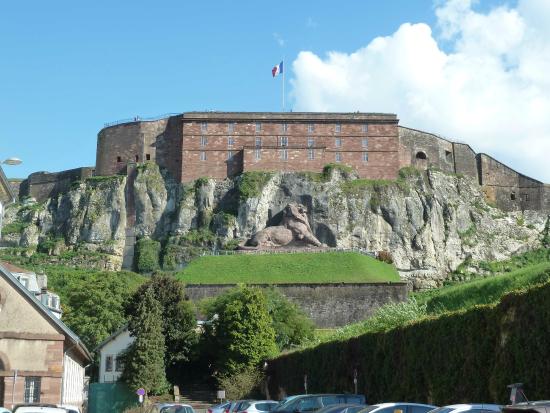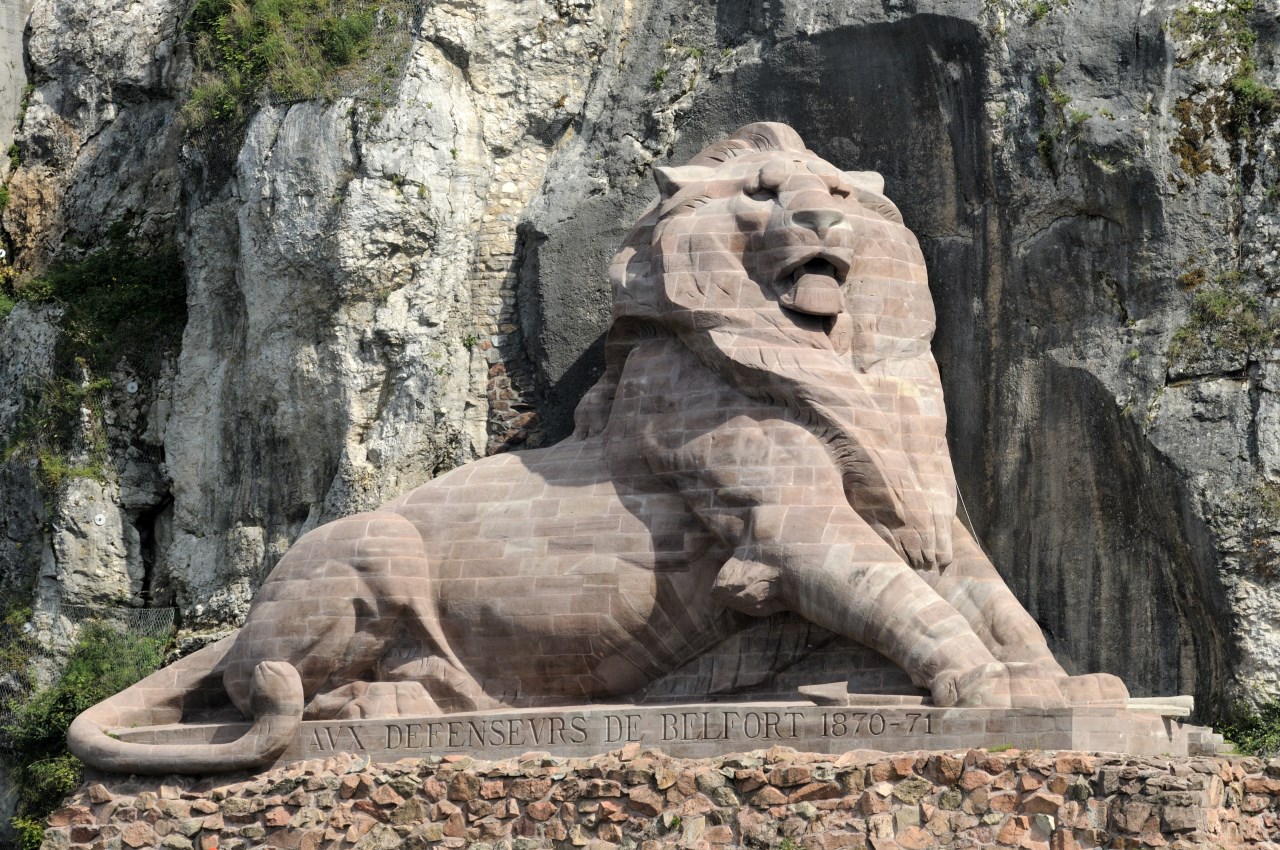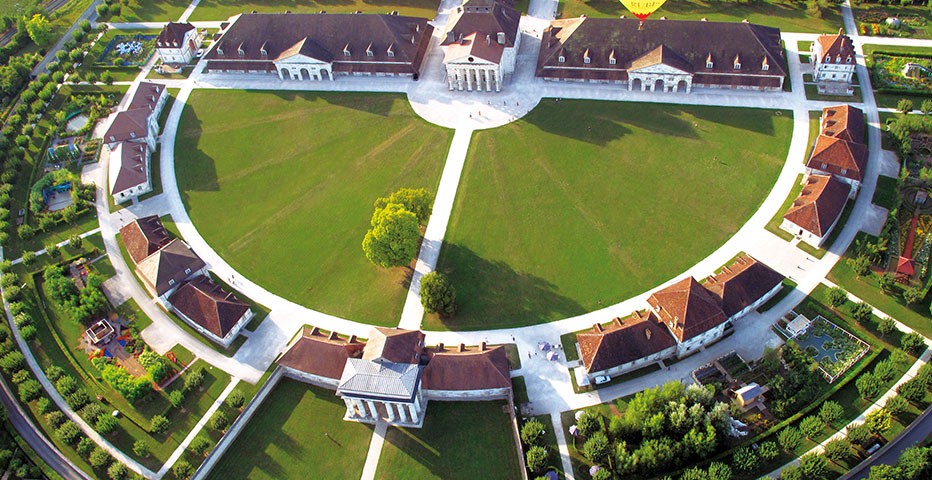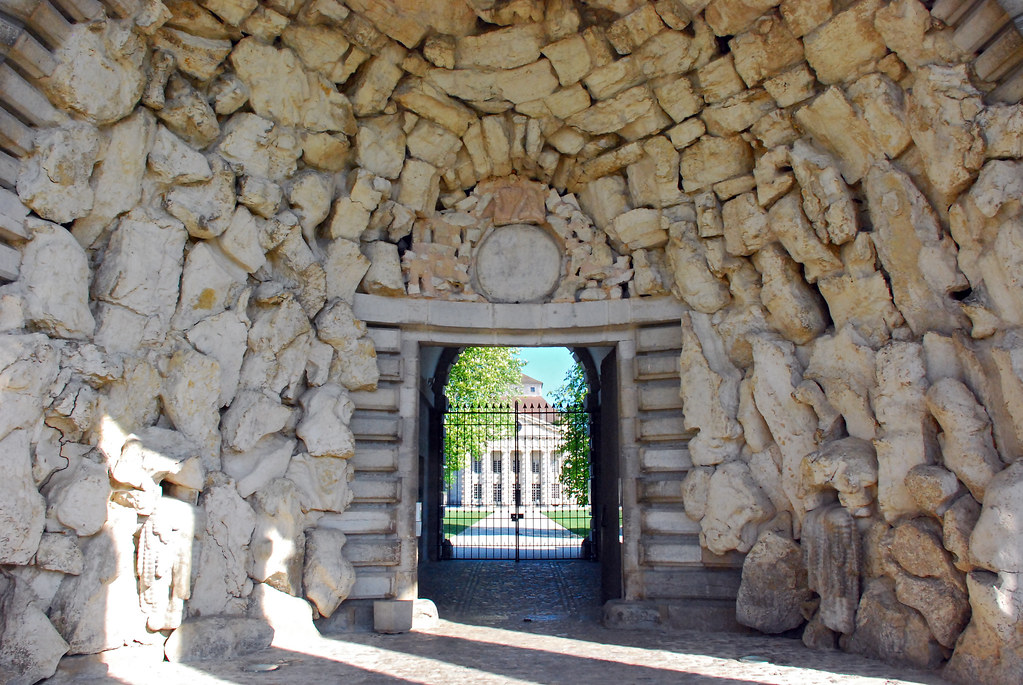France – Franche-Comté (Besançon, Belfort) September 13, 2019
BELFORT (pop 50,200)
This city in northeastern France in the Bourgogne-Franche-Comté région is situated between Lyon and Strasbourg and approximately 25kms from the French-Swiss border. Belfort is 400kms from Paris, 141kms from Strasbourg, 290 kms from Lyon and 150kms from Zürich. The residents of the city are called “Belfortains”. The city is located on the Savoureuse River, on a strategically important natural route between the Rhine and the Rhône – the Belfort Gap (Trouée de Belfort) or Burgundian Gate (Porte de Bourgogne). It is located approximately 16kms south from the base of the Ballon d’Alsace mountain range, source of the Savoureuse.
Citadelle de Belfort. The first fort here was built in the 13th century. A bastioned front was added in 1648. From 1687-1703, the great French military architect, Vauban added many fortifications to produce what you see today. It resisted a prolonged siege in 1813-14 in the Franco-Prussian War. The perimeter was reinforced in 1842 and in the siege of 1870-71 proved that it could resist shelling. It had no role in either world wars.
It has magnificent bastioned walls built on the rough stone base, typical of Vauban’s work, surrounding an enclosed 14 hectares plus the Great Underground Passage. The bastions continue down into the town. It was listed as a WHS (Forts of Vauban) in 2005. It can be entered for free.


Lion of Belfort. This magnificent sculpture of a lion was produced in from 1872-80 by the architect Auguste Bertholdi to honor the resistance of the 16,000 citizens of Belfort during the Franco-Prussian War of 1870-71 when they defended the city after the French government had already surrendered. It sits on the rock face below the walls of the Citadel of Belfort, in a place that can be seen from anywhere in Belfort. Constructed of blocks of stone, the lion is 11m high and 22m long and tramples a broken arrow under its right front paw. On its front base is the inscription: AVX DEFENSEVRS DE BELFORT 1870-71. There are great views of the city from the terrace with signs showing all the buildings.
It is a symbol of the city of Belfort, a symbol of stand fastness, strength and valor, a lion harassed and cornered but still terrifying. A plaster model of the lion is in Paris.

Notre Dame du Haut, Ronchamp. This church was designed by Corbusier (1857-1965) and built in 1953-5. The Nortre Dame du Bas church (Lower Our Lady church) is the parish church down in the town of Ronchamp. The upper church is built on a hill used since Greco-Roman times and has been a pilgrimage site since the 11th century. On Aug 15 of each year, Assumption Day, and again on September 8 (Nativity of the Virgin), it holds a pilgrims festival .
The exterior is dramatic: an oval tower is on the upper side and presents no windows as you approach it (the windows are on the north side). A huge grey reinforced concrete, curved, overlapping roof tops the church (actually a hollow shell made of two thin membranes held up by 16 steel pillars inserted into the non-load bearing walls). The facade seen on approach is a rising unequal trapezoid with 27 windows, all rectangles and squares, each a different size. That wall is 3m thick constructed of steel covered with a thin layer of concrete sprayed with a cement gun and whitewashed. On the inside there are 3 small triangular chapels in this wall. The windows are multi-paned small squares red, yellow, green and with printed images.
The front is concave, overlapped by the roof and is an outside choir that can address 2000 pilgrims without a microphone.
The inside: The tower is an empty cylinder lit by constant north light and has a small concrete altar. There is a concrete altar in the apse, a concrete pulpit and a square window in the front with an 18th century Virgin and Christ statue that can rotate when the outside choir is used. The nice wood pews were designed by Corbusier.
Outside is a 8-step peace pyramid (built using the stones from the remains of the old chapel), pilgrim shelter and chaplain’s house. €8
BESANCON (pop 116,500, metropolitan area 251,000)
It is the capital of the department of Doubs in the region of Bourgogne-Franche-Comté. The city is located in Eastern France, close to the Jura Mountains and the border with Switzerland. As the capital of the historic and cultural region of Franche-Comté it is an important administrative centre. It is also the seat of one of the two divisions of the French Army.
Established in a meander of the Doubs river, the city was already important during the Gallo-Roman era under the name of Vesontio, capital of the Sequani. Its geography and specific history turned it into a military stronghold, a garrison city, a political center, and a religious capital.
Besançon is the historical capital of watchmaking in France. This has led it to become a center for innovative companies in the fields of microtechnology, micromechanics, and biomedical engineering. The University of Franche-Comté, founded in 1423, every year enrolls more than 20,000 students; its Centre for Applied Linguistics enrolls another estimated 4,000 trainees from all over the world.
The greenest city in France, it enjoys a quality of life recognized in Europe. Thanks to its rich historical and cultural heritage and its unique architecture, Besançon has been labeled a “Town of Art and History” since 1986.
Musée des Beaux-Arts et d’Archéologie de Besançon. This local history museum has all the local archaeology from the Stone Age to Medieval times. The artists are primarily local. €8
Citadel of Besançon. As one of Vauban’s military architecture masterpieces, it is considered one of the most beautiful in France, it rises over 100m above the old town of Besancon, with great panoramas. The Citadel occupies 11 hectares (27 acres) on Mount Saint-Etienne, one of the seven hills that protect Besançon, the capital of Franche-Comté. Mount Saint-Etienne occupies the neck of an oxbow formed by the river Doubs, giving the site a strategic importance that Julius Caesar recognised as early as 58 BC. The Citadel overlooks the old quarter of the city, which is located within the oxbow, and has views of the city and its surroundings.
Built in 1668, the fortification is well preserved. Today it is an important tourist site (over a quarter of a million visitors per year) due both to its own characteristics and because it is the site of several museums. These museums include a museum of the Resistance and deportation, a museum focusing on traditional life in Franche-Comté and the region’s archeological history, and a museum of natural history that includes a zoo, an insectarium, an aquarium, vivariums, a noctarium, a climatorium, a pedagogical exhibit on evolution, botanical gardens, and a children’s farm. There is also a restaurant and shops.
On 7 July 2008, UNESCO listed the Citadel, together with nearby Fort Griffon, as a World Heritage Site.
Access by bus, car (a road exists on both side but neither could be found by Google Maps) or on foot on four marked trails with a map available from the tourist office. Entry free
My third day in France was a big one for World Heritage Sites – I saw four, this one in Franche-Comté and three in Burgundy, but it was a lot of driving.
From the Great Saltworks of Salins-les-Bains to the Royal Saltworks of Arc-et-Senans, the Production of Open-pan Salt.
The Royal Saltworks of Arc-et-Senans is about 35kms SW of Besancon, and I arrived at opening at 9am. Declared a WHS in 1982 primarily for its architecture, this salt production facility was founded in the reign of Louis XV between 1775-9. It consists of a semi-circle of 11 masterful stone buildings all with great arched facades, built to produce salt using heat to boil off the water. It closed when industrial production of salt occurred in 1895. It was saved from destruction many times. 


There is nothing in the buildings that show any actual salt producing objects but rather a bunch of disconnected exhibits – it appears that they were hard up to use all the space.
Other than the sign at the door of each building and a plasticized card in most rooms, there is no English so you get a very terse summary of the place.
Enter the magnificent portal full of rough boulders. The first building is the woodworking shops (the salt was sold in barrels made on sight or as blocks) with an exhibit about the architect, Nicolas Ledoux, a true genius who designed many wonderful buildings in France – most are produced here as very nice white scale models. There is a 31-room hotel that can’t be entered. The worker’s dormitory can’t be entered. Next is a large exhibit on Woodstock (yes the New York music festival in the late 60s – go figure). The large central building, the manager’s house, has the exhibit on salt production showing many places around the world with open-pan salt and salt mines. The videos are in French and have French subtitles – go figure!!!!!). The water was boiled off in four iron basins 1m high taking about 24-72 hours. This building was blown up by its owner, the Eastern Salt Company, in 1926 in protest to the building being designated a historical building!!!! (only the French do crazy things like this). The next building has an exhibit on Jules Verne (yes the author, nothing to do with salt). The most interesting place is the forges where tools and the hoops for the barrels were made.
All in all, this was kind of a waste of time if one were only interested in salt and couldn’t speak French, but the buildings are wonderful. €10.50
NOMAD MANIA France – Franche-Comté (Besançon, Belfort)
World Heritage Sites
Fortifications of Vauban
From the Great Saltworks of Salins-les-Bains to the Royal Saltworks of Arc-et-Senans, the Production of Open-pan Salt
Prehistoric Pile dwellings around the Alps
The Architectural Work of Le Corbusier, an Outstanding Contribution to the Modern Movement
Tentative WHS
Sites funéraires et mémoriels de la Première Guerre mondiale (Front Ouest) (07/04/2014)
Borders: France-Switzerland
XL: Hotel Arbez Franco-Suisse
House Museums/Plantations: Arbois: Maison Louis Pasteur
Castles, Palaces, Forts
La Cluse-et-Mijoux: Joux Castle
Pontarlier: Fort de Joux
Religious Temples: Ronchamp: Notre Dame du Haut (Corbusier)
Windmills: Courvières: Moulin de Courvières
Open-Air Museums: Nancray: Musée de plein air des maisons comtoises
Bizzarium: Montbenoît: Saugeais (micronation)
European Cities
BESANCON
Railway, Metro, Funiculars, Cable Cars: Besançon Trams
Museums: Musée des Beaux-Arts et d’Archéologie de Besançon
Castles, Palaces, Forts: Citadel of Besançon
Villages and Small Towns
Mouthier-Haute-Pierre
Salains-les-Bains
BELFORT
Castles, Palaces, Forts: Citadelle de Belfort
Planetariums: Belfort Planetarium
Monuments: Belfort: Lion of Belfort
Festivals: Les Eurockéennes, Belfort
SOCHAUX
Museums: Sochaux: Musée de l’Aventure Peugeot
Vehicle Museums: Sochaux: Musée de l’Aventure Peugeot

